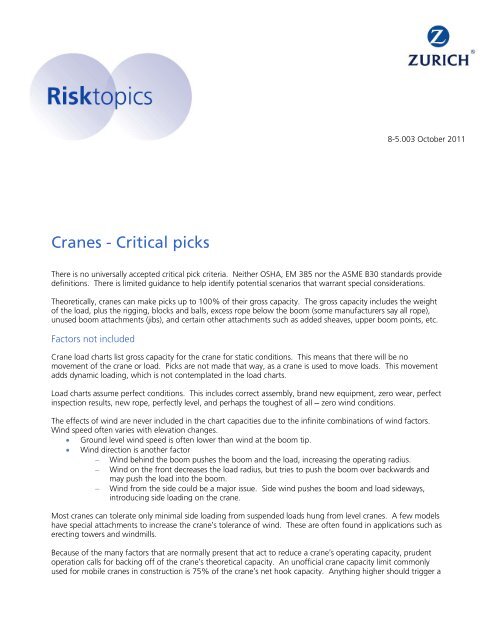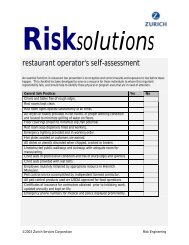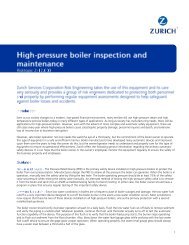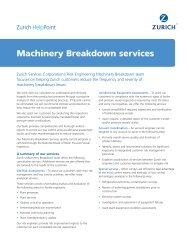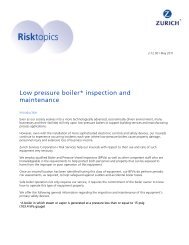Cranes - Critical picks - Risk Engineering
Cranes - Critical picks - Risk Engineering
Cranes - Critical picks - Risk Engineering
Create successful ePaper yourself
Turn your PDF publications into a flip-book with our unique Google optimized e-Paper software.
8-5.003 October 2011<br />
<strong>Cranes</strong> - <strong>Critical</strong> <strong>picks</strong><br />
There is no universally accepted critical pick criteria. Neither OSHA, EM 385 nor the ASME B30 standards provide<br />
definitions. There is limited guidance to help identify potential scenarios that warrant special considerations.<br />
Theoretically, cranes can make <strong>picks</strong> up to 100% of their gross capacity. The gross capacity includes the weight<br />
of the load, plus the rigging, blocks and balls, excess rope below the boom (some manufacturers say all rope),<br />
unused boom attachments (jibs), and certain other attachments such as added sheaves, upper boom points, etc.<br />
Factors not included<br />
Crane load charts list gross capacity for the crane for static conditions. This means that there will be no<br />
movement of the crane or load. Picks are not made that way, as a crane is used to move loads. This movement<br />
adds dynamic loading, which is not contemplated in the load charts.<br />
Load charts assume perfect conditions. This includes correct assembly, brand new equipment, zero wear, perfect<br />
inspection results, new rope, perfectly level, and perhaps the toughest of all – zero wind conditions.<br />
The effects of wind are never included in the chart capacities due to the infinite combinations of wind factors.<br />
Wind speed often varies with elevation changes.<br />
Ground level wind speed is often lower than wind at the boom tip.<br />
Wind direction is another factor<br />
Wind behind the boom pushes the boom and the load, increasing the operating radius.<br />
Wind on the front decreases the load radius, but tries to push the boom over backwards and<br />
may push the load into the boom.<br />
Wind from the side could be a major issue. Side wind pushes the boom and load sideways,<br />
introducing side loading on the crane.<br />
Most cranes can tolerate only minimal side loading from suspended loads hung from level cranes. A few models<br />
have special attachments to increase the crane’s tolerance of wind. These are often found in applications such as<br />
erecting towers and windmills.<br />
Because of the many factors that are normally present that act to reduce a crane’s operating capacity, prudent<br />
operation calls for backing off of the crane’s theoretical capacity. An unofficial crane capacity limit commonly<br />
used for mobile cranes in construction is 75% of the crane’s net hook capacity. Anything higher should trigger a
critical pick plan. Even when conditions are nearly ideal, prudent operation suggests backing off a bit from the<br />
manufacturer’s limits. Anything higher than 90% should be considered to be a very risky undertaking.<br />
The construction industry has informally developed internal criteria to designate critical <strong>picks</strong>. Uniformity is<br />
lacking, but there are many areas of general agreement. Scenarios that warrant consideration to trigger critical<br />
pick planning are:<br />
<br />
<br />
<br />
<br />
<br />
<br />
<br />
<br />
Load weight, including rigging, exceeds 75% of the crane’s net hook capacity<br />
Very expensive loads<br />
Loads that would take significant time to replace<br />
Loads with unusual characteristics<br />
Dangerous materials<br />
Liquid filled containers<br />
Multi-crane <strong>picks</strong><br />
Crane set on a structure such as a bridge deck, pier or platform<br />
Unusual hazards<br />
Over open highways or rail lines<br />
Near high hazard environments<br />
Project owner’s requirements<br />
Picks of personnel are not necessarily considered to be critical. OSHA requirements limit cranes to 50% of their<br />
capacity, and 50% of the rope working limits when picking personnel. This is well below the commonly<br />
accepted threshold of 75% used to trigger critical pick plans. There are other requirements such as wind speed<br />
limits and daily test <strong>picks</strong> listed in the OSHA rules. Refer to OSHA 1926.1431 for more details.<br />
Preparation for a critical pick<br />
Written planning is essential. Usually, the most qualified entity performs the planning for all crane <strong>picks</strong>,<br />
including critical <strong>picks</strong>. This is often the crane owner, as he knows the equipment, manufacturer’s requirements<br />
and is usually the employer of the operator. Sometimes, a team approach is appropriate. Often a review of the<br />
pick plans by a general contractor or project owner may be a contractual requirement. Most plans come in two<br />
parts, preparation and calculation:<br />
<br />
<br />
<br />
<br />
<br />
<br />
Identification of project<br />
Description of the load<br />
Proposed date<br />
Crane details<br />
Make, model and serial number<br />
Crane base (crawlers, outriggers, rubber)<br />
Verification of correct load chart<br />
Required operating radius<br />
Quadrant(s) of operation<br />
Pick elevations at start, max and landing<br />
Lowest gross capacity at minimum height, maximum radius, weakest quadrant<br />
Jibs (if used)<br />
Type, length, capacity and offset<br />
Structural capacity (if less than the crane)<br />
Site details<br />
Above ground hazards (power lines and obstructions)<br />
Underground hazards (buried objects)<br />
At grade hazards (roadways, pedestrians, water and rail lines)<br />
Soil conditions (bearing capacity - mats required?)<br />
Engineered base capacity (bridge decks, piers)<br />
Load details
Exact weight of the load<br />
Additional weight of rigging, bracing, extras<br />
Special characteristics (possible center of gravity shifts)<br />
Rigging plan<br />
Type, size and capacity of:<br />
Slings including lengths<br />
Sling hitch types and angles<br />
Shackles<br />
Hooks<br />
Spreaders<br />
Balancers (come-alongs)<br />
All hardware capacity equal or greater than slings<br />
Personnel<br />
Crane operator(s)<br />
Certifications<br />
Experience in type and model proposed for the pick<br />
Riggers<br />
Qualified for type of rigging<br />
Certifications where required<br />
Lift director<br />
Technical qualifications equal to the crane operator(s)<br />
Familiar with the crane manufacturer’s manuals and requirements<br />
Signaler(s)<br />
Written record of training<br />
Written test and acceptance by employer or third party<br />
Experienced in signal methods to be used (voice, hand)<br />
Visual identification of the signaler<br />
Calculation<br />
The basic premise of the load and capacity calculations is fairly straightforward. The gross load is tabulated by<br />
adding the actual load weight to the rigging, boom attachments and crane rope weights. The gross load is<br />
divided by the crane’s gross capacity to determine the planned percentage of the crane’s capacity. In the<br />
examples suggested above, anything above 75% would be a critical pick, and over 90% should be reconsidered.<br />
The actual order of the calculations will vary on different plan forms. The final answer should be the same.<br />
There are potentially some special considerations that may apply. These vary with type of operation,<br />
manufacturer’s instructions and local conditions. A partial list includes:<br />
<br />
<br />
<br />
<br />
<br />
<br />
<br />
<br />
<br />
Power lines – minimum clearances maintained at all times, designated spotter required<br />
Aircraft – proximity to airport or crane taller than 200 feet may require 30-day advance notification to<br />
the FAA: http://forms.faa.gov/forms/faa7460-1.pdf<br />
Duty cycle deductions – repetitive, similar lifts<br />
Electrical interference – potential voltages from AM radio, nearby power lines<br />
Pick and carry – walking the crane with a load on the hook<br />
Potential interference from the load or crane on medical or other equipment (hospitals and refineries)<br />
Multiple loads on the hook (Christmas treeing)<br />
Questionable underpinning – soil conditions and special blocking<br />
Water operations – <strong>picks</strong> by a crane on a barge<br />
Always read and follow the crane manufacturer’s guidance, instructions and requirements.<br />
The last step prior to implementation of the critical pick plan is to communicate the plan to all affected parties.<br />
This is usually accomplished in a pre-lift meeting with the team. Essential team members include the lift planner,
lift director, riggers, signalers and of course, the crane operators. In some cases, the team is expanded to include<br />
spotters, project engineers, surveyors and safety staff. Having a good plan is important. Following the plan is<br />
essential for a safe pick.
Zurich Services Corporation<br />
<strong>Risk</strong> <strong>Engineering</strong><br />
1400 American Lane, Schaumburg, Illinois 60196-1056<br />
800 982 5964 www.zurichna.com<br />
The information in this publication was compiled by Zurich Services Corporation from sources<br />
believed to be reliable for informational purposes only. All sample policies and procedures<br />
herein should serve as a guideline, which you can use to create your own policies and<br />
procedures. We trust that you will customize these samples to reflect your own operations<br />
and believe that these samples may serve as a helpful platform for this endeavor. Any and all<br />
information contained herein is not intended to constitute legal advice and accordingly, you<br />
should consult with your own attorneys when developing programs and policies. We do not<br />
guarantee the accuracy of this information or any results and further assume no liability in<br />
connection with this publication and sample policies and procedures, including any<br />
information, methods or safety suggestions contained herein. Moreover, Zurich Services<br />
Corporation reminds you that this cannot be assumed to contain every acceptable safety and<br />
compliance procedure or that additional procedures might not be appropriate under the<br />
circumstances The subject matter of this publication is not tied to any specific insurance<br />
product nor will adopting these policies and procedures ensure coverage under any insurance<br />
policy.<br />
©2011 Zurich Services Corporation


